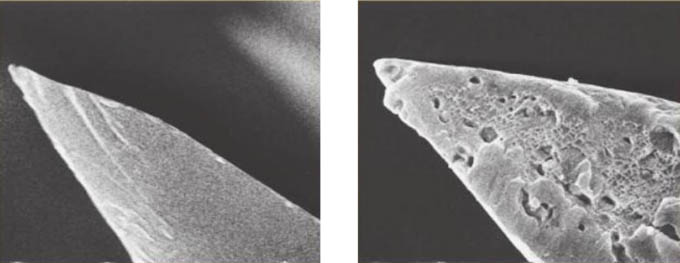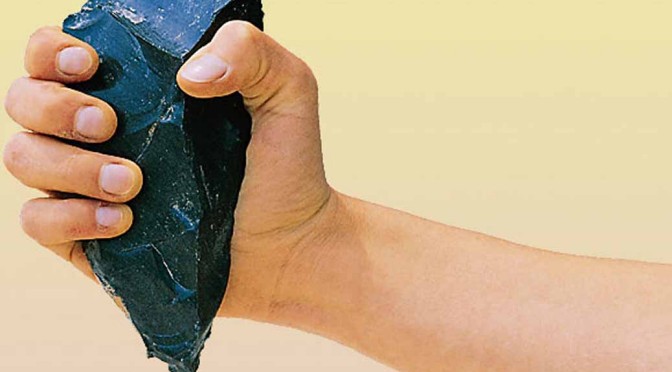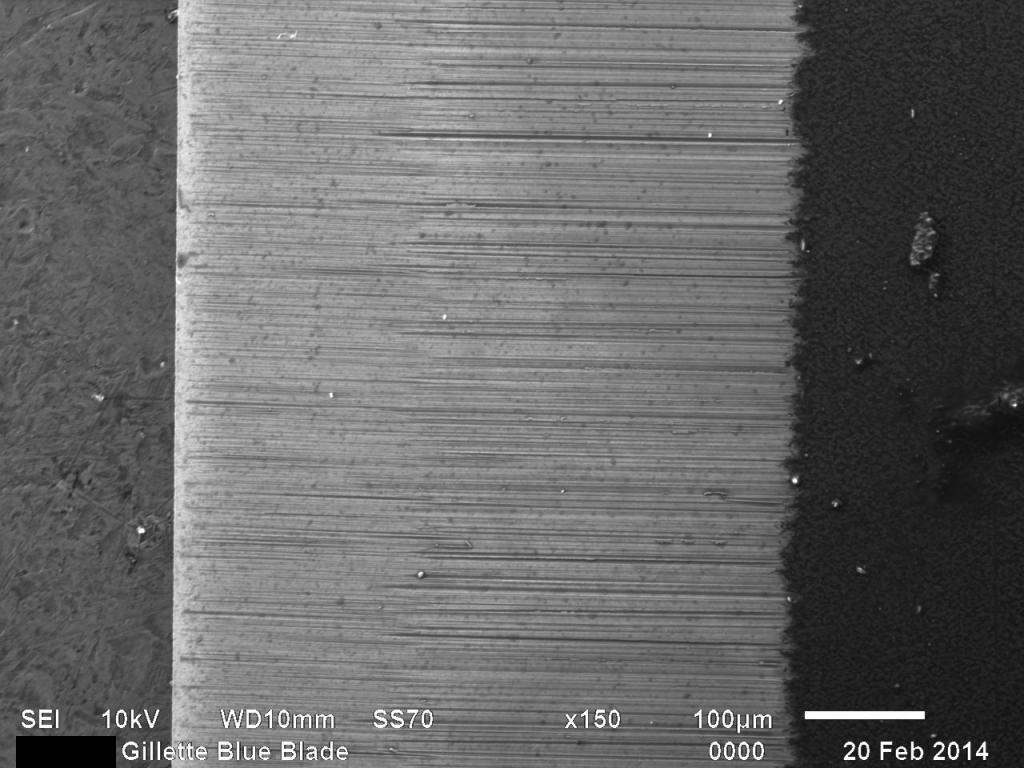By Anupum Pant
Normally, the electric shaver gets the work done. So, I almost never have to use a fixed blade razor for shaving my facial hair, but after seeing this, I think I should start using a fixed blade. Here is a highly magnified image (using a scanning electron microscope) of two strands of hair. The left one was cut using a fixed blade and the right one was cut using an electric razor. See the difference for yourself.
So, even if the major thing that causes a messed up strand is due to the fast moving blade of an electric razor, but one other important factor is the sharpness of the blade. The point is, electric shaver blades aren’t too sharp, while fixed blade steel razors are pretty sharp. Thus, the steel blades can give you a clean cut.
Still, when it comes to fine tools, steel blades stand nowhere. Look at what a Gillette blade looks like when its put under an electron microscope (at not even a very high magnification – 150x).
Yes, even those seemingly perfect Gillette blades can be that jagged under high magnification. Thank goodness, blades can get much finer.
Obsidian Blades
Obsidian is a naturally occurring black volcanic glass. A glassy rock, you could say. It is very hard and of course, like most hard things are, it is brittle too. So, if it isn’t handled with good care, it breaks pretty easily. Yes, that kind of a rock.
When it breaks, it forms very sharp edges. These edges can sometimes get much much sharper than your normal steel blades. Also, even if they are brittle, they are pretty durable in a sense that they can hold their edge for much longer times. These were the reason, our ancient palaeolithic ancestors used to chip these rocks and made them as the tips of their spears and arrows.
Blade edges made out of obsidian are so sharp that they don’t seem jagged even when seen under an electron microscope. Their edges, if made carefully using processes like pressure flaking process, can get up to 3 nm thick. Good quality blades can make cuts down to single molecules! That is about 500 times sharper than the sharpest steel blade.

While blade edges made out of obsidian are not approved by the FDA, surgeon scalpels are still made using them. Studies say that cuts made using these blades get healed much faster than the ones made by steel blades because obsidian blades can make extremely narrow cuts between the cells, and not tear the cells apart.
Lee A. Green, associate professor of family practice at the Medical Center, uses obsidian knives for removing moles and repairing torn earlobes. – Source
Of course synthetic diamond blades have been made. But obsidian blades are still better in terms of durability.
Stone age technology is still the best.
Please hit like if you learnt something from this article.



It will be better if you can post a magnified Image of an obsidian blade edge.
Hey, thanks for the suggestion. Adding one comparison right away. I know there could be a better one, but we’ll get a little idea from this.
It seems like a far as beard hair goes, it makes more sense to have a furrier edge so your face is softer vs a stiff sharp edge. Right?
Actually what looks furrier in the microscope is really a better cutting edge than a straight edge. So the furrier one actually gives you a more rough edge, even though it looks as if it would be nice and furry.
Same goes for knives. If you look a really sharp knife under a high powered microscope, or an electron microscope, you’d see furry looking edges. These are what gives the knives a better cutting edge as compared to the other edges.
Well, not to put too fine a point on it, but obsidian is not as durable as you seem to think. It dulls quickly. This is one of its weaknesses. Another, very important, weakness is that it takes a lot of modern technology to make an acceptable scalpel from obsidian.
Obsidian is extremely sharp, but it is also highly inconsistent in the way it breaks. It can be very difficult to get an uninterrupted edge that’s more than a few millimeters long. Even though an obsidian edge may look perfect to the naked eye, it can be chipped, or angled every few millimeters, which makes cutting difficult.
Primitive technology may have the sharpest blade, but it’s far from the best.